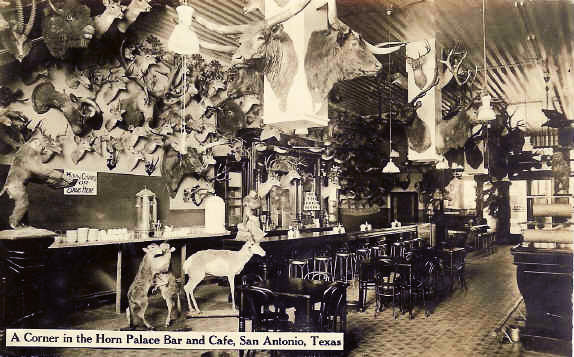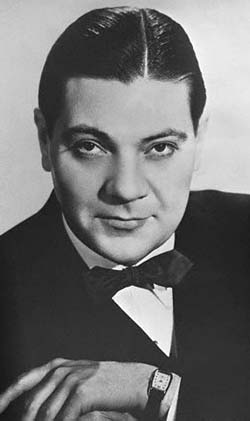Trombone legend Jack Teagarden and Jim Cullum, Sr. and Jr. have shared a special affection for the classical sounds of jazz in the 1920s and 30s, and Cullum Sr. also shared the bandstand with Teagarden on numerous occasions. Riverwalk Jazz recalls the legacy of Jack Teagarden with two hour-long tributes featuring San Francisco Bay Area trombonist and bandleader Rex Allen. This radio show, Jack Teagarden: Back Roads of Texas, follows Jack and his trombone through the dusty back roads of Texas in the 20s, from grimy oilfields in western Texas, to Sylvan Beach on Galveston Bay. Through the courtesy of archivist Joe Showler and his renowned Jack Teagarden Collection, the broadcast includes historical tapes of 'Big T' talking about his life in music.
The publicity photo of Jack Teagarden seen here bears the inscription: "To Vic, Best of Everything, Jack Teagarden." Teagarden autographed the photo for Vic Moore, drummer of the Wolverines, the first band Bix Beiderbecke recorded with in the early 20s. Moore gave his photo collection to Jim Cullum, Sr. and Jr. in 1963 when the father and son hot jazz bandleaders launched The Landing jazz club in San Antonio. Many vintage jazz photos from Vic Moore's collection were displayed on the walls of The Landing for decades.
Popular Jazz Age bandleader Paul Whiteman once described Jack Teagarden's playing this way:
"They talk about hot jazz and cool jazz but when it comes to Jack Teagarden there's another phrase that fits his music—Warm Jazz. He has an emotional and yet always controlled way of playing—full of meaning and compassion."
Jack got his first steady job in 1920 in a San Antonio road house called the Horn Palace not far from The Landing's location on the San Antonio River. He was a fifteen-year-old kid with slicked-back hair and a handsome face. Jack's first reaction to San Antonio was, "It's the biggest town I've ever seen!" At that time, San Antonio was the biggest city in the Southwest.

The Horn Palace. Photo courtesy of Special Collections, University of Houston Libraries.
On the heels of a shoot out at the Horn Palace and the famous flood of 1921, Jack decided it was time to hit the road. He headed for Houston and then Galveston, where he began a long association with the legendary pianist Peck Kelley. The Jim Cullum Jazz Band's rendition of the 1922 tune "On the Alamo" evokes the summer nights Jack played for dancers on Galveston Bay with Peck's Bad Boys.
Jack Teagarden kept coming back to San Antonio. In 1926 he was playing at the Somerset Club in San Antonio with the New Orleans Rhythm Masters. The Somerset was a hot night spot at the height of Prohibition with gambling and drinks—and outdoor dancing in an era before air conditioning.

Jack Teagarden. Photo courtesy wikimedia.
Jim Cullum says, "Jack Teagarden was to become the greatest of all Texas jazzmen. He revolutionized the role of trombone and is still thought of as its greatest exponent. In addition to his virtuosity, he brought a depth of feeling or 'soul' which has seldom been equaled."
On this broadcast, trombonist Rex Allen sits in with The Jim Cullum Jazz Band on tunes associated with Jack Teagarden including, "Love Lies," "Weary Bllues," and "St. James Infirmary."
In the late 20s, Jack Teagarden became a mainstay of the jazz scene in New York City. It was 1933 when he recorded Harold Arlen and Ted Koehler's "I Gotta Right to Sing the Blues," Teagarden's soon-to-be theme song with a small ensemble featuring Benny Goodman on clarinet. Be sure to catch the second hour of this two-part series Jack Teagarden: Big City Jazz in the Forties.
Photo credit for Home Page: Jack Teagarden inscribed to Vic Moore. Photo courtesy Joe Showler.
Text based on Riverwalk Jazz script by Margaret Moos Pick ©2001


